第三节 MongoDB下samus源码初探
上一节我们在samus的simple例子简单的入门了,这一节将要探讨的问题写个简要
- 对象存储
- 继续关系对象的存储
- LINQ体现
- 类关系分析
一、对象存储
继续在samus源码上分析,依然是simple的例子。Demo中.net 3.5特性基本上都涉及了。
public
static
void
Main(
string
[] args)
{
#region 以下为Mongo配置及关系映射部分
// var config = new MongoConfigurationBuilder();
// COMMENT OUT FROM HERE
// config.Mapping(mapping =>
// {
// mapping.DefaultProfile(profile =>
// {
// profile.SubClassesAre(t => t.IsSubclassOf(typeof(MyClass)));
// });
// mapping.Map<MyClass>();
// mapping.Map<SubClass>();
// });
// TO HERE
#endregion
// config.ConnectionString("Server=127.0.0.1");
// using (Mongo mongo = new Mongo(config.BuildConfiguration()))
using (Mongo mongo = new Mongo( " Server=127.0.0.1 " ))
{
mongo.Connect();
try
{
// 索引器方式mogo["TestDb"]
var db = mongo.GetDatabase( " TestDb " );
// 老版不支持泛型的时候写法是这样的db.GetCollection("Name") ->看源码重构了一个MongoCollection_1类
// 将老版方法重构为db.GetCollection<Documnet>("Name");
// 此方法其实将类名反射为集合 db.GetCollection<MyClass>("MyClass")
var collection = db.GetCollection < MyClass > ();
// .net 3.5集合初始化特性 创建3个对象(2个MyClass,1个子类SubClass)
MyClass square = new MyClass()
{
Corners = 4 ,
Name = " Square "
};
MyClass circle = new MyClass()
{
Corners = 0 ,
Name = " Circle "
};
SubClass sub = new SubClass()
{
Name = " SubClass " ,
Corners = 6 ,
Ratio = 3.43
};
// 保存对象
collection.Save(square);
collection.Save(circle);
collection.Save(sub);
#region LINQ写法读取数据
// var superclass = (from item in db.GetCollection<MyClass>("MyClass").Linq()
// where item.Corners > 1
// select item.Corners).ToList();
// var subclass = (from item in db.GetCollection<SubClass>("MyClass").Linq()
// where item.Ratio > 1
// select item.Corners).ToList();
#endregion
// Lambda写法
// 读取集合MyClass所有对象
Console.WriteLine( " Count by LINQ on typed collection: {0} " , collection.Linq().Count(x => x.Corners > 1 ));
// 读取集合为SubClass的对象(由于SubClass被保存到MyClass集合中了,故结果为0)
Console.WriteLine( " Count by LINQ on typed collection2: {0} " , db.GetCollection < SubClass > ().Linq().Count(x => x.Corners > 1 ));
// Console.WriteLine("Count by LINQ on typed collection3: {0}", db.GetCollection<SubClass>().Count(new { Corners = Op.GreaterThan(1) }));
// 注:op 是Document的子类 虽然我们存的是其它对象,但所有的对象最终都是以Document类型存储的,
// 也就意味检索数据也是Document方式查找或统计了,以下Lambda方式的统计就体现了
// 在基类中大家可以看到都是count(new Document())方式及条件查询的,这里介绍完了,下面的代码就容易理解了
Console.WriteLine( " Count on typed collection: {0} " , collection.Count( new { Corners = Op.GreaterThan( 1 ) }));
var count = collection.Count( new Document( " Corners " , Op.GreaterThan( 1 )));
Console.WriteLine( " Count: {0} " , count);
Console.ReadKey();
}
finally
{
mongo.Disconnect();
}
}
// var main = new MainClass();
// main.Setup();
// main.Run();
Console.ReadLine();
}
{
#region 以下为Mongo配置及关系映射部分
// var config = new MongoConfigurationBuilder();
// COMMENT OUT FROM HERE
// config.Mapping(mapping =>
// {
// mapping.DefaultProfile(profile =>
// {
// profile.SubClassesAre(t => t.IsSubclassOf(typeof(MyClass)));
// });
// mapping.Map<MyClass>();
// mapping.Map<SubClass>();
// });
// TO HERE
#endregion
// config.ConnectionString("Server=127.0.0.1");
// using (Mongo mongo = new Mongo(config.BuildConfiguration()))
using (Mongo mongo = new Mongo( " Server=127.0.0.1 " ))
{
mongo.Connect();
try
{
// 索引器方式mogo["TestDb"]
var db = mongo.GetDatabase( " TestDb " );
// 老版不支持泛型的时候写法是这样的db.GetCollection("Name") ->看源码重构了一个MongoCollection_1类
// 将老版方法重构为db.GetCollection<Documnet>("Name");
// 此方法其实将类名反射为集合 db.GetCollection<MyClass>("MyClass")
var collection = db.GetCollection < MyClass > ();
// .net 3.5集合初始化特性 创建3个对象(2个MyClass,1个子类SubClass)
MyClass square = new MyClass()
{
Corners = 4 ,
Name = " Square "
};
MyClass circle = new MyClass()
{
Corners = 0 ,
Name = " Circle "
};
SubClass sub = new SubClass()
{
Name = " SubClass " ,
Corners = 6 ,
Ratio = 3.43
};
// 保存对象
collection.Save(square);
collection.Save(circle);
collection.Save(sub);
#region LINQ写法读取数据
// var superclass = (from item in db.GetCollection<MyClass>("MyClass").Linq()
// where item.Corners > 1
// select item.Corners).ToList();
// var subclass = (from item in db.GetCollection<SubClass>("MyClass").Linq()
// where item.Ratio > 1
// select item.Corners).ToList();
#endregion
// Lambda写法
// 读取集合MyClass所有对象
Console.WriteLine( " Count by LINQ on typed collection: {0} " , collection.Linq().Count(x => x.Corners > 1 ));
// 读取集合为SubClass的对象(由于SubClass被保存到MyClass集合中了,故结果为0)
Console.WriteLine( " Count by LINQ on typed collection2: {0} " , db.GetCollection < SubClass > ().Linq().Count(x => x.Corners > 1 ));
// Console.WriteLine("Count by LINQ on typed collection3: {0}", db.GetCollection<SubClass>().Count(new { Corners = Op.GreaterThan(1) }));
// 注:op 是Document的子类 虽然我们存的是其它对象,但所有的对象最终都是以Document类型存储的,
// 也就意味检索数据也是Document方式查找或统计了,以下Lambda方式的统计就体现了
// 在基类中大家可以看到都是count(new Document())方式及条件查询的,这里介绍完了,下面的代码就容易理解了
Console.WriteLine( " Count on typed collection: {0} " , collection.Count( new { Corners = Op.GreaterThan( 1 ) }));
var count = collection.Count( new Document( " Corners " , Op.GreaterThan( 1 )));
Console.WriteLine( " Count: {0} " , count);
Console.ReadKey();
}
finally
{
mongo.Disconnect();
}
}
// var main = new MainClass();
// main.Setup();
// main.Run();
Console.ReadLine();
}
看一下结果:
在打开mongo.exe查看一下结果
是不是很奇怪,MyClass,SubClass对象又没有标记为可序列化,如何就被保存下来了?难道是通过反射对实现的,看看源码
二、继续关系对象的存储
当数据保存为文档记录时,MongoDB是如何识别这个两类是有继承关系的呢?我们接着下面的代码修改一下继续
先删除上次的记录,在mongo.exe中运行db.MyClass.drop() 删除集合中的数据,查看更多操作集合的命令可执行db.MyClass.help
mongo.exe脚本命令官方介绍用的是Javascript脚本,从命名可以看出是它的影子。mongo.exe的脚本学习可参照这个链接
http://special.csdn.net/mongodb/index.html
public
static
void
Main(
string
[] args)
{
#region 以下为Mongo配置及关系映射部分
var config = new MongoConfigurationBuilder();
// COMMENT OUT FROM HERE 建立两者的关系
config.Mapping(mapping =>
{
mapping.DefaultProfile(profile =>
{
profile.SubClassesAre(t => t.IsSubclassOf( typeof (MyClass)));
});
mapping.Map < MyClass > ();
mapping.Map < SubClass > ();
});
// TO HERE
#endregion
config.ConnectionString( " Server=127.0.0.1 " );
// 将配置注入Mongo类中
using (Mongo mongo = new Mongo(config.BuildConfiguration()))
{
mongo.Connect();
try
{
// 索引器方式mogo["TestDb"]
var db = mongo.GetDatabase( " TestDb " );
// 老版不支持泛型的时候写法是这样的db.GetCollection("Name") ->看源码重构了一个MongoCollection_1类
// 将老版方法重构为db.GetCollection<Documnet>("Name");
// 此方法其实将类名反射为集合 db.GetCollection<MyClass>("MyClass")
var collection = db.GetCollection < MyClass > ();
// .net 3.5集合初始化特性 创建3个对象(2个MyClass,1个子类SubClass)
MyClass square = new MyClass()
{
Corners = 4 ,
Name = " Square "
};
MyClass circle = new MyClass()
{
Corners = 0 ,
Name = " Circle "
};
SubClass sub = new SubClass()
{
Name = " SubClass " ,
Corners = 6 ,
Ratio = 3.43
};
// 保存对象
collection.Save(square);
collection.Save(circle);
collection.Save(sub);
#region LINQ写法读取数据
// var superclass = (from item in db.GetCollection<MyClass>("MyClass").Linq()
// where item.Corners > 1
// select item.Corners).ToList();
// var subclass = (from item in db.GetCollection<SubClass>("MyClass").Linq()
// where item.Ratio > 1
// select item.Corners).ToList();
#endregion
// Lambda写法
// 读取集合MyClass所有对象
Console.WriteLine( " Count by LINQ on typed collection: {0} " , collection.Linq().Count(x => x.Corners > 1 ));
// 读取集合为SubClass的对象(由于SubClass被保存到MyClass集合中了,故结果为0)
Console.WriteLine( " Count by LINQ on typed collection2: {0} " , db.GetCollection < SubClass > ().Linq().Count(x => x.Corners > 1 ));
// Console.WriteLine("Count by LINQ on typed collection3: {0}", db.GetCollection<SubClass>().Count(new { Corners = Op.GreaterThan(1) }));
// 注:op 是Document的子类 虽然我们存的是其它对象,但所有的对象最终都是以Document类型存储的,
// 也就意味检索数据也是Document方式查找或统计了,以下Lambda方式的统计就体现了
// 在基类中大家可以看到都是count(new Document())方式及条件查询的,这里介绍完了,下面的代码就容易理解了
Console.WriteLine( " Count on typed collection: {0} " , collection.Count( new { Corners = Op.GreaterThan( 1 ) }));
var count = collection.Count( new Document( " Corners " , Op.GreaterThan( 1 )));
Console.WriteLine( " Count: {0} " , count);
Console.ReadKey();
}
finally
{
mongo.Disconnect();
}
}
// var main = new MainClass();
// main.Setup();
// main.Run();
Console.ReadLine();
}
{
#region 以下为Mongo配置及关系映射部分
var config = new MongoConfigurationBuilder();
// COMMENT OUT FROM HERE 建立两者的关系
config.Mapping(mapping =>
{
mapping.DefaultProfile(profile =>
{
profile.SubClassesAre(t => t.IsSubclassOf( typeof (MyClass)));
});
mapping.Map < MyClass > ();
mapping.Map < SubClass > ();
});
// TO HERE
#endregion
config.ConnectionString( " Server=127.0.0.1 " );
// 将配置注入Mongo类中
using (Mongo mongo = new Mongo(config.BuildConfiguration()))
{
mongo.Connect();
try
{
// 索引器方式mogo["TestDb"]
var db = mongo.GetDatabase( " TestDb " );
// 老版不支持泛型的时候写法是这样的db.GetCollection("Name") ->看源码重构了一个MongoCollection_1类
// 将老版方法重构为db.GetCollection<Documnet>("Name");
// 此方法其实将类名反射为集合 db.GetCollection<MyClass>("MyClass")
var collection = db.GetCollection < MyClass > ();
// .net 3.5集合初始化特性 创建3个对象(2个MyClass,1个子类SubClass)
MyClass square = new MyClass()
{
Corners = 4 ,
Name = " Square "
};
MyClass circle = new MyClass()
{
Corners = 0 ,
Name = " Circle "
};
SubClass sub = new SubClass()
{
Name = " SubClass " ,
Corners = 6 ,
Ratio = 3.43
};
// 保存对象
collection.Save(square);
collection.Save(circle);
collection.Save(sub);
#region LINQ写法读取数据
// var superclass = (from item in db.GetCollection<MyClass>("MyClass").Linq()
// where item.Corners > 1
// select item.Corners).ToList();
// var subclass = (from item in db.GetCollection<SubClass>("MyClass").Linq()
// where item.Ratio > 1
// select item.Corners).ToList();
#endregion
// Lambda写法
// 读取集合MyClass所有对象
Console.WriteLine( " Count by LINQ on typed collection: {0} " , collection.Linq().Count(x => x.Corners > 1 ));
// 读取集合为SubClass的对象(由于SubClass被保存到MyClass集合中了,故结果为0)
Console.WriteLine( " Count by LINQ on typed collection2: {0} " , db.GetCollection < SubClass > ().Linq().Count(x => x.Corners > 1 ));
// Console.WriteLine("Count by LINQ on typed collection3: {0}", db.GetCollection<SubClass>().Count(new { Corners = Op.GreaterThan(1) }));
// 注:op 是Document的子类 虽然我们存的是其它对象,但所有的对象最终都是以Document类型存储的,
// 也就意味检索数据也是Document方式查找或统计了,以下Lambda方式的统计就体现了
// 在基类中大家可以看到都是count(new Document())方式及条件查询的,这里介绍完了,下面的代码就容易理解了
Console.WriteLine( " Count on typed collection: {0} " , collection.Count( new { Corners = Op.GreaterThan( 1 ) }));
var count = collection.Count( new Document( " Corners " , Op.GreaterThan( 1 )));
Console.WriteLine( " Count: {0} " , count);
Console.ReadKey();
}
finally
{
mongo.Disconnect();
}
}
// var main = new MainClass();
// main.Setup();
// main.Run();
Console.ReadLine();
}
结果:
再看mongo.exe中的记录:
三、LINQ的体现
#region
LINQ写法读取数据
var myCollection = (from item in db.GetCollection < MyClass > ( " MyClass " ).Linq()
where item.Corners > 1
select item).ToList();
foreach (MyClass my in myCollection)
{
Console.WriteLine(my.Name + " : " + my.Corners.ToString());
}
var subCollection = (from item in db.GetCollection < SubClass > ( " MyClass " ).Linq()
where item.Ratio > 1
select item).ToList();
foreach (SubClass subClass in subCollection)
{
Console.WriteLine(subClass.Name + " : " + subClass.Ratio.ToString());
}
var superclass = (from item in db.GetCollection < MyClass > ( " MyClass " ).Linq()
where item.Corners > 1
select item.Corners).ToList();
var subclass = (from item in db.GetCollection < SubClass > ( " MyClass " ).Linq()
where item.Ratio > 1
select item.Corners).ToList();
#endregion
var myCollection = (from item in db.GetCollection < MyClass > ( " MyClass " ).Linq()
where item.Corners > 1
select item).ToList();
foreach (MyClass my in myCollection)
{
Console.WriteLine(my.Name + " : " + my.Corners.ToString());
}
var subCollection = (from item in db.GetCollection < SubClass > ( " MyClass " ).Linq()
where item.Ratio > 1
select item).ToList();
foreach (SubClass subClass in subCollection)
{
Console.WriteLine(subClass.Name + " : " + subClass.Ratio.ToString());
}
var superclass = (from item in db.GetCollection < MyClass > ( " MyClass " ).Linq()
where item.Corners > 1
select item.Corners).ToList();
var subclass = (from item in db.GetCollection < SubClass > ( " MyClass " ).Linq()
where item.Ratio > 1
select item.Corners).ToList();
#endregion
结果:
以上就是LINQ的查找数据的方式,更多的方法还要研究一下源码的MongDB下的LINQ文件夹。
四、类关系分析
以上四个类是MongoDB的基本业务类,从数据库连接,到实例,集合的CRUD操作。
我们在看一下配置映射类图:
配置类组合的类比较多,具体还有哪些功能,在后面的学习过程在继续挖掘了。
好了这一节就到这里了,继续探讨复杂对象的储存。







